Abstract
The tissue uptake of extensively plasma-bound compounds is reportedly inconsistent with the conventional free-drug hypothesis limiting transport to unbound moiety in rapid intracapillary equilibrium with bound complex. Instead, protein-mediated/cell surface enhancement of dissociation has been postulated to occur in the microvasculature. This possibility was investigated by studying the passive transport of diazepam across the blood-brain barrier. Microdialysis probes placed within the vena cava and brain cortex were used to directly compare steady-state, interstitial unbound diazepam levels in both Wistar and genetically analbuminemic rats. The absence of albumin in the latter increased the unbound fraction of diazepam by almost fivefold; however, in both groups, the ratio of unbound concentrations in brain and blood at equilibrium was equal to unity. If enhanced dissociation occurred in the microvasculature, then the unbound brain level should have been greater than that in the systemic circulation. It is probable that earlier findings suggestive of protein-mediated transport reflect a nonequilibrium phenomenon. Comparison of the extent of diazepam's in vivo binding in blood by microdialysis to that estimated in vitro using conventional equilibrium dialysis with microcells showed good agreement, thus validating a widely accepted assumption of equivalency of these two values.
Full text
PDF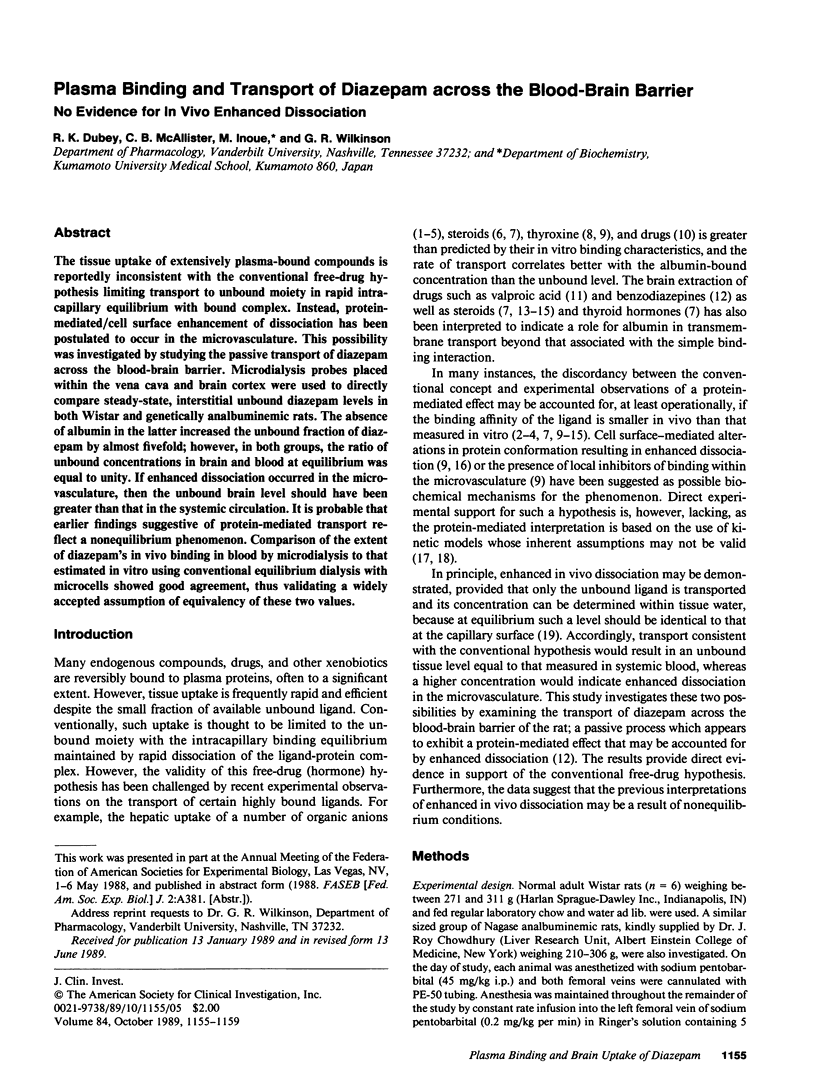
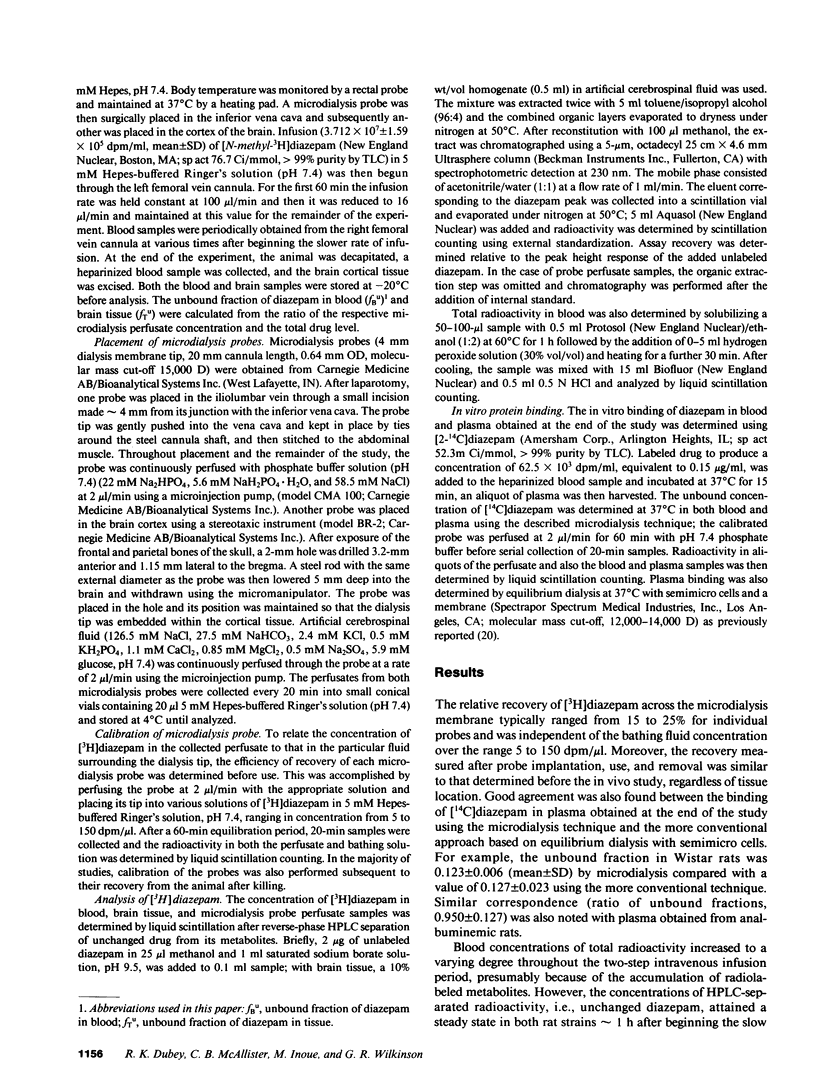
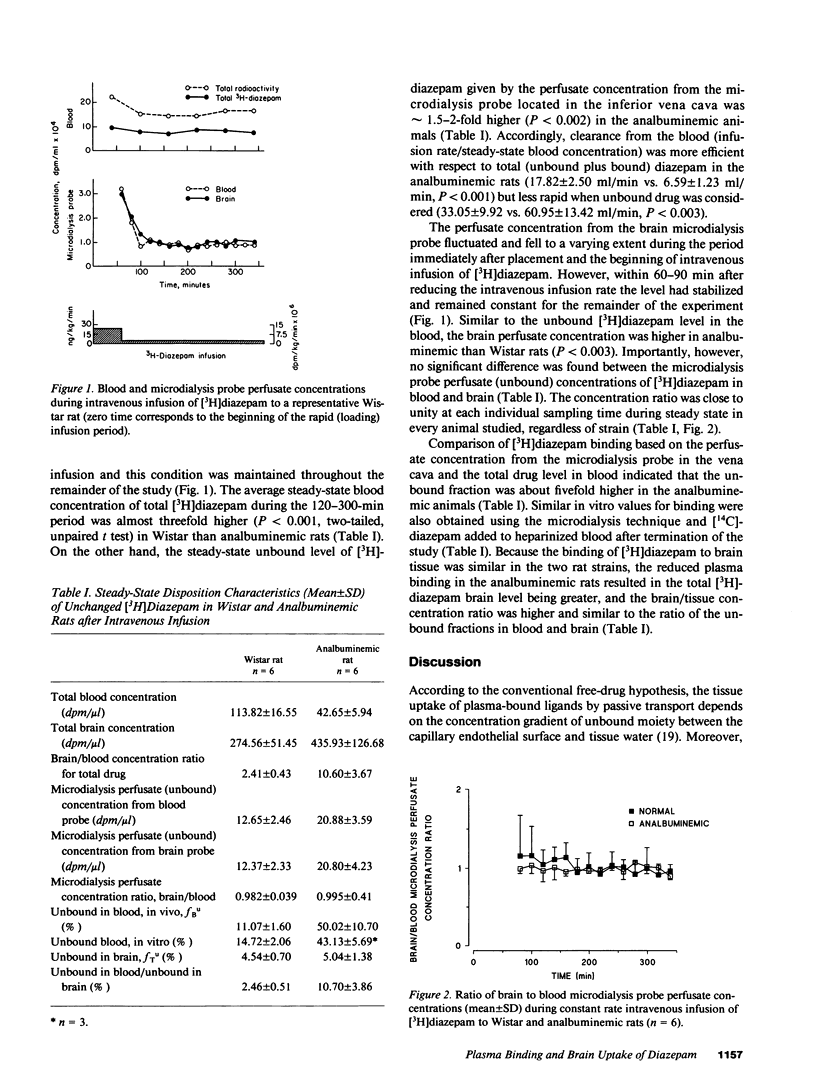
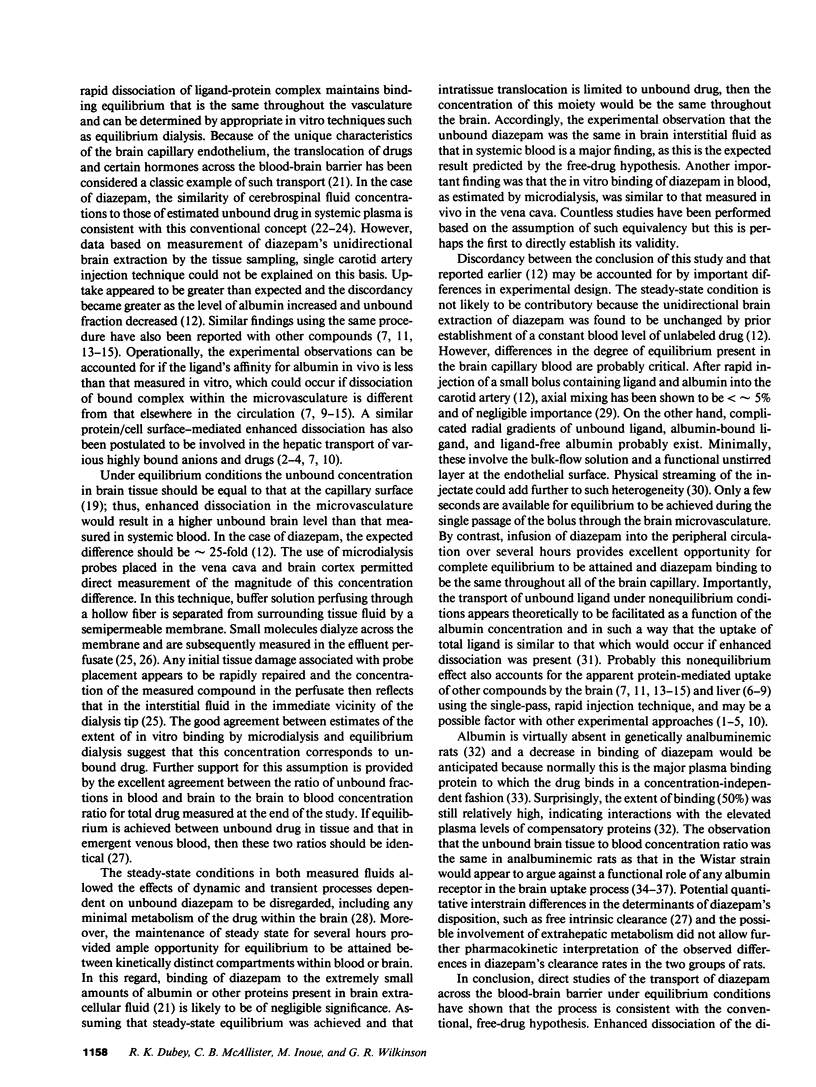
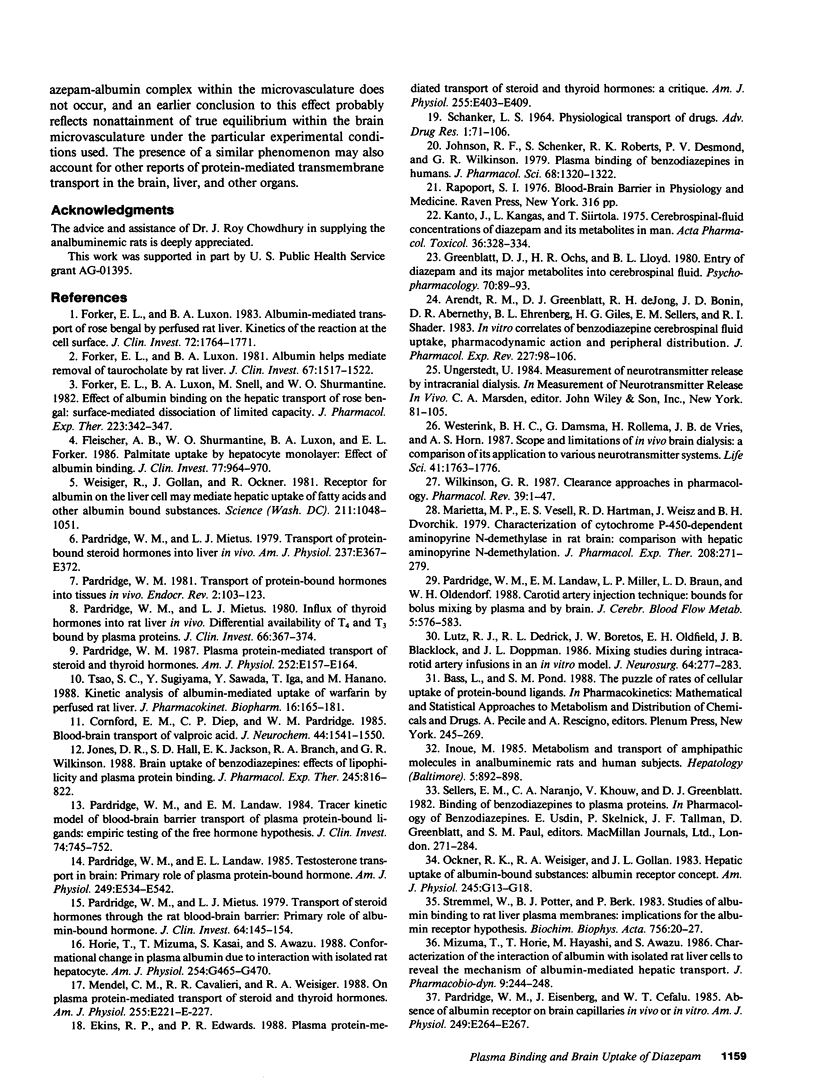
Selected References
These references are in PubMed. This may not be the complete list of references from this article.
- Arendt R. M., Greenblatt D. J., deJong R. H., Bonin J. D., Abernethy D. R., Ehrenberg B. L., Giles H. G., Sellers E. M., Shader R. I. In vitro correlates of benzodiazepine cerebrospinal fluid uptake, pharmacodynamic action and peripheral distribution. J Pharmacol Exp Ther. 1983 Oct;227(1):98–106. [PubMed] [Google Scholar]
- Cornford E. M., Diep C. P., Pardridge W. M. Blood-brain barrier transport of valproic acid. J Neurochem. 1985 May;44(5):1541–1550. doi: 10.1111/j.1471-4159.1985.tb08793.x. [DOI] [PubMed] [Google Scholar]
- Elkins R. P., Edwards P. R. Plasma protein-mediated transport of steroid and thyroid hormones: a critique. Am J Physiol. 1988 Sep;255(3 Pt 1):E403–E409. doi: 10.1152/ajpendo.1988.255.3.E403. [DOI] [PubMed] [Google Scholar]
- Fleischer A. B., Shurmantine W. O., Luxon B. A., Forker E. L. Palmitate uptake by hepatocyte monolayers. Effect of albumin binding. J Clin Invest. 1986 Mar;77(3):964–970. doi: 10.1172/JCI112397. [DOI] [PMC free article] [PubMed] [Google Scholar]
- Forker E. L., Luxon B. A. Albumin helps mediate removal of taurocholate by rat liver. J Clin Invest. 1981 May;67(5):1517–1522. doi: 10.1172/JCI110182. [DOI] [PMC free article] [PubMed] [Google Scholar]
- Forker E. L., Luxon B. A. Albumin-mediated transport of rose bengal by perfused rat liver. Kinetics of the reaction at the cell surface. J Clin Invest. 1983 Nov;72(5):1764–1771. doi: 10.1172/JCI111136. [DOI] [PMC free article] [PubMed] [Google Scholar]
- Forker E. L., Luxon B. A., Snell M., Shurmantine W. O. Effect of albumin binding on the hepatic transport of rose bengal: surface-mediated dissociation of limited capacity. J Pharmacol Exp Ther. 1982 Nov;223(2):342–347. [PubMed] [Google Scholar]
- Greenblatt D. J., Ochs H. R., Lloyd B. L. Entry of diazepam and its major matabolite into cerebrospinal fluid. Psychopharmacology (Berl) 1980;70(1):89–93. doi: 10.1007/BF00432376. [DOI] [PubMed] [Google Scholar]
- Horie T., Mizuma T., Kasai S., Awazu S. Conformational change in plasma albumin due to interaction with isolated rat hepatocyte. Am J Physiol. 1988 Apr;254(4 Pt 1):G465–G470. doi: 10.1152/ajpgi.1988.254.4.G465. [DOI] [PubMed] [Google Scholar]
- Inoue M. Metabolism and transport of amphipathic molecules in analbuminemic rats and human subjects. Hepatology. 1985 Sep-Oct;5(5):892–898. doi: 10.1002/hep.1840050531. [DOI] [PubMed] [Google Scholar]
- Johnson R. F., Schenker S., Roberts R. K., Desmond P. V., Wilkinson G. R. Plasma binding of benzodiazepines in humans. J Pharm Sci. 1979 Oct;68(10):1320–1322. doi: 10.1002/jps.2600681034. [DOI] [PubMed] [Google Scholar]
- Jones D. R., Hall S. D., Jackson E. K., Branch R. A., Wilkinson G. R. Brain uptake of benzodiazepines: effects of lipophilicity and plasma protein binding. J Pharmacol Exp Ther. 1988 Jun;245(3):816–822. [PubMed] [Google Scholar]
- Kanto J., Kangas L., Siirtola T. Cerebrospinal-fluid concentration of diazepam and its metabolites in man. Acta Pharmacol Toxicol (Copenh) 1975 Apr;36(4):328–334. doi: 10.1111/j.1600-0773.1975.tb00800.x. [DOI] [PubMed] [Google Scholar]
- Lutz R. J., Dedrick R. L., Boretos J. W., Oldfield E. H., Blacklock J. B., Doppman J. L. Mixing studies during intracarotid artery infusions in an in vitro model. J Neurosurg. 1986 Feb;64(2):277–283. doi: 10.3171/jns.1986.64.2.0277. [DOI] [PubMed] [Google Scholar]
- Marietta M. P., Vesell E. S., Hartman R. D., Weisz J., Dvorchik B. H. Characterization of cytochrome P-450-dependent aminopyrine N-demethylase in rat brain: comparison with hepatic aminopyrine N-demethylation. J Pharmacol Exp Ther. 1979 Feb;208(2):271–279. [PubMed] [Google Scholar]
- Mendel C. M., Cavalieri R. R., Weisiger R. A. On plasma protein-mediated transport of steroid and thyroid hormones. Am J Physiol. 1988 Aug;255(2 Pt 1):E221–E227. doi: 10.1152/ajpendo.1988.255.2.E221. [DOI] [PubMed] [Google Scholar]
- Mizuma T., Horie T., Hayashi M., Awazu S. Characterization of the interaction of albumin with isolated rat liver cells to reveal the mechanism of albumin-mediated hepatic transport. J Pharmacobiodyn. 1986 Mar;9(3):244–248. doi: 10.1248/bpb1978.9.244. [DOI] [PubMed] [Google Scholar]
- Ockner R. K., Weisiger R. A., Gollan J. L. Hepatic uptake of albumin-bound substances: albumin receptor concept. Am J Physiol. 1983 Jul;245(1):G13–G18. doi: 10.1152/ajpgi.1983.245.1.G13. [DOI] [PubMed] [Google Scholar]
- Pardridge W. M., Eisenberg J., Cefalu W. T. Absence of albumin receptor on brain capillaries in vivo or in vitro. Am J Physiol. 1985 Sep;249(3 Pt 1):E264–E267. doi: 10.1152/ajpendo.1985.249.3.E264. [DOI] [PubMed] [Google Scholar]
- Pardridge W. M., Landaw E. M., Miller L. P., Braun L. D., Oldendorf W. H. Carotid artery injection technique: bounds for bolus mixing by plasma and by brain. J Cereb Blood Flow Metab. 1985 Dec;5(4):576–583. doi: 10.1038/jcbfm.1985.86. [DOI] [PubMed] [Google Scholar]
- Pardridge W. M., Landaw E. M. Testosterone transport in brain: primary role of plasma protein-bound hormone. Am J Physiol. 1985 Nov;249(5 Pt 1):E534–E542. doi: 10.1152/ajpendo.1985.249.5.E534. [DOI] [PubMed] [Google Scholar]
- Pardridge W. M., Landaw E. M. Tracer kinetic model of blood-brain barrier transport of plasma protein-bound ligands. Empiric testing of the free hormone hypothesis. J Clin Invest. 1984 Sep;74(3):745–752. doi: 10.1172/JCI111490. [DOI] [PMC free article] [PubMed] [Google Scholar]
- Pardridge W. M., Mietus L. J. Influx of thyroid hormones into rat liver in vivo. Differential availability of thyroxine and triiodothyronine bound by plasma proteins. J Clin Invest. 1980 Aug;66(2):367–374. doi: 10.1172/JCI109865. [DOI] [PMC free article] [PubMed] [Google Scholar]
- Pardridge W. M., Mietus L. J. Transport of protein-bound steroid hormones into liver in vivo. Am J Physiol. 1979 Oct;237(4):E367–E372. doi: 10.1152/ajpendo.1979.237.4.E367. [DOI] [PubMed] [Google Scholar]
- Pardridge W. M., Mietus L. J. Transport of steroid hormones through the rat blood-brain barrier. Primary role of albumin-bound hormone. J Clin Invest. 1979 Jul;64(1):145–154. doi: 10.1172/JCI109433. [DOI] [PMC free article] [PubMed] [Google Scholar]
- Pardridge W. M. Transport of protein-bound hormones into tissues in vivo. Endocr Rev. 1981 Winter;2(1):103–123. doi: 10.1210/edrv-2-1-103. [DOI] [PubMed] [Google Scholar]
- Schanker L. S. Physiological transport of drugs. Adv Drug Res. 1964;1:71–106. [PubMed] [Google Scholar]
- Stremmel W., Potter B. J., Berk P. D. Studies of albumin binding to rat liver plasma membranes. Implications for the albumin receptor hypothesis. Biochim Biophys Acta. 1983 Mar 15;756(1):20–27. doi: 10.1016/0304-4165(83)90019-3. [DOI] [PubMed] [Google Scholar]
- Tsao S. C., Sugiyama Y., Sawada Y., Iga T., Hanano M. Kinetic analysis of albumin-mediated uptake of warfarin by perfused rat liver. J Pharmacokinet Biopharm. 1988 Apr;16(2):165–181. doi: 10.1007/BF01062259. [DOI] [PubMed] [Google Scholar]
- Weisiger R., Gollan J., Ockner R. Receptor for albumin on the liver cell surface may mediate uptake of fatty acids and other albumin-bound substances. Science. 1981 Mar 6;211(4486):1048–1051. doi: 10.1126/science.6258226. [DOI] [PubMed] [Google Scholar]
- Westerink B. H., Damsma G., Rollema H., De Vries J. B., Horn A. S. Scope and limitations of in vivo brain dialysis: a comparison of its application to various neurotransmitter systems. Life Sci. 1987 Oct 12;41(15):1763–1776. doi: 10.1016/0024-3205(87)90695-3. [DOI] [PubMed] [Google Scholar]
- Wilkinson G. R. Clearance approaches in pharmacology. Pharmacol Rev. 1987 Mar;39(1):1–47. [PubMed] [Google Scholar]


